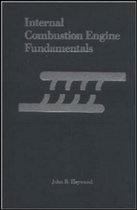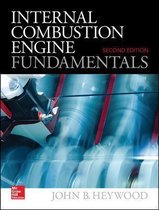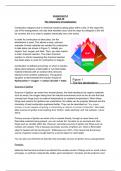Combustion Study guides, Class notes & Summaries
Looking for the best study guides, study notes and summaries about Combustion? On this page you'll find 6040 study documents about Combustion.
Popular textbooks 'Combustion' · Show all (5) Hide
All books 5 HideAll 6.040 results
Sort by
![AQA AS CHEMISTRY 7404/2 Paper 2 Organic and Physical Chemistry Question Paper + Mark scheme [MERGED] June 2022 *JUN227404201* IB/M/Jun22/E7 7404/2 For Examiner’s Use Question Mark 1](/docpics/2844126/647a6b19e9a0a_2844126_121_171.jpeg) Popular
Popular
-
AQA AS CHEMISTRY 7404/2 Paper 2 Organic and Physical Chemistry Question Paper + Mark scheme [MERGED] June 2022 *JUN227404201* IB/M/Jun22/E7 7404/2 For Examiner’s Use Question Mark 1
- Exam (elaborations) • 63 pages • 2023
- Available in package deal
-
- $7.99
- 13x sold
- + learn more
AQA AS CHEMISTRY 7404/2 Paper 2 Organic and Physical Chemistry Question Paper + Mark scheme [MERGED] June 2022 *JUN* IB/M/Jun22/E7 7404/2 For Examiner’s Use Question Mark 1 2 3 4 5 6 7 Section B TOTAL Time allowed: 1 hour 30 minutes Materials For this paper you must have: • the Periodic Table/Data Sheet, provided as an insert (enclosed) • a ruler with millimetre measurements • a scientific calculator, which you are expected to use where appropriate. Instructions...
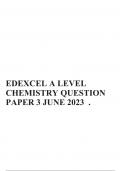 Popular
Popular
-
EDEXCEL A LEVEL CHEMISTRY QUESTION PAPER 3 JUNE 2023 .
- Exam (elaborations) • 33 pages • 2023 Popular
-
- $4.99
- 11x sold
- + learn more
EDEXCEL A LEVEL CHEMISTRY QUESTION PAPER 3 JUNE 2023 . Centre Number Candidate Number *P71914A0132* Turn over Total Marks Candidate surname Other names Please check the examination details below before entering your candidate information Paper reference P71914A ©2023 Pearson Education Ltd. N:1/1/1/1/1/1/ You must have: Scientific calculator, Data Booklet, ruler Friday 23 June 2023 Instructions • Use black ink or ball-point pen. • If pencil is used for diagrams/sk...
Got a distinction. The highlighted case study is optional and added that in case a resub was needed, but got a distinction without it.
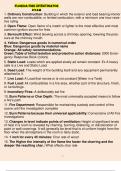
-
Florida Fire Investigator Exam Course Florida Fire Investigator Institution Florida Fire Investigator Ordinary Construction - Answer- Building in which the exterior and load bearing interior walls are non-combustible, or limited combustion, with a minimum
- Exam (elaborations) • 12 pages • 2023
-
- $13.19
- 1x sold
- + learn more
Florida Fire Investigator Exam Course Florida Fire Investigator Institution Florida Fire Investigator Ordinary Construction - Answer- Building in which the exterior and load bearing interior walls are non-combustible, or limited combustion, with a minimum one hour resistive rating Open Flame
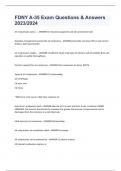
-
FDNY A-35 Exam Questions & Answers 2023/2024
- Exam (elaborations) • 9 pages • 2023
-
- $11.99
- 9x sold
- + learn more
FDNY A-35 Exam Questions & Answers 2023/2024 Air compressors power... - ANSWER-(1) industrial equipment and (2) construction tools Examples of equipment powered by air compressor - ANSWER-pneumatic wrenches, lifts in auto service stations, paint spray booths Air compressors enable... - ANSWER-(1) efficient repair of all types of vehicles; and (2) facilitate their safe operation on public thoroughfares Permit is required for air compressor - ANSWER-that compresses air above 100 PSI ...

-
Oil Burner License Exam 2023 Questions and Answers
- Exam (elaborations) • 18 pages • 2023
-
Available in package deal
-
- $12.49
- 3x sold
- + learn more
What is the first thing a tech should do when arriving at a no combustion call? - Answer- Ask how many times the customer reset the unit. What is the best long term solution for preventing a clogged nozzle? - Answer- -Remove any underground storage tanks. -Install a quality oil filter. -Cut the suction line 10" above the tank outlet to prevent sludge. Hot water and steam valves are interchangeable. - Answer- False When in the presence of a flame, a cad cell normally reads.. - Answe...
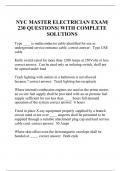
-
NYC MASTER ELECTRICIAN EXAM| 230 QUESTIONS| WITH COMPLETE SOLUTIONS
- Exam (elaborations) • 34 pages • 2023
-
Available in package deal
-
- $12.99
- 3x sold
- + learn more
Type ____ is multiconductor cable identified for use as underground service entrance cable. correct answer: Type USE cable Knife switch rated for more than 1200 Amps at 250Volts or less correct answer: Can be used only as isolating switch, shall not be opened under load Track lighting with outlets in a bathroom is not allowed because ? correct answer: Track lighting has receptacle Where internal combustion engines are used as the prime motor, an on site fuel supply shall be provided ...
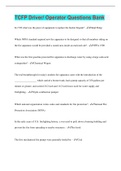
-
TCFP Driver/ Operator Questions Bank | 600 Questions with 100% Correct Answers | Verified | Latest Update | 82 Pages
- Exam (elaborations) • 82 pages • 2023
- Available in package deal
-
- $24.49
- 3x sold
- + learn more
In 1720 what was the piece of equipment to replace the bucket brigade? - Hand Pump Which NFPA standard required new fire apparatus to be designed so that all members riding on the fire apparatus would be provided a seated area inside an enclosed cab? - NFPA 1500 What was the first gasoline powered fire apparatus to discharge water by using a large soda acid extinguisher? - Chemical Wagon The real breakthrough for today's modern fire apparatus came with the introduction of the ____________...
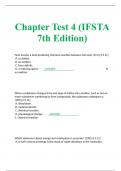
-
Chapter Test 4 (IFSTA 7th Edition)
- Exam (elaborations) • 26 pages • 2023
- Available in package deal
-
- $9.99
- 1x sold
- + learn more
Chapter Test 4 (IFSTA 7th Edition) Fires involve a heat-producing chemical reaction between fuel and: (117) [4.3.11] A. a catalyst. B. an oxidizer. C. free radicals. D. a reducing agent. - ANSWER B. an oxidizer When a substance changes from one type of matter into another, such as two or more substances combining to form compounds, the substance undergoes a: (118) [4.3.11] A. dissolutio...
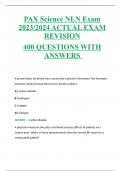
-
PAX Science NLN Exam 2023/2024 ACTUAL EXAM REVISION 400 QUESTIONS WITH ANSWERS
- Exam (elaborations) • 70 pages • 2023
- Available in package deal
-
- $9.49
- 3x sold
- + learn more
PAX Science NLN Exam 2023/2024 ACTUAL EXAM REVISION 400 QUESTIONS WITH ANSWERS A person blows his breath into a straw that is placed in limewater. The limewater becomes cloudy because the person's breath contains A.) carbon dioxide. B.) hydrogen. C.) oxygen. D.) nitrogen. ANSWER ~: carbon dioxide. A physician measures the pulse and blood pressure (BP) of all patients on a routine basis. Which of these measurements show the normal BP values for a resting adult patient? A.) 125/95 ...

Study stress? For sellers on Stuvia, these are actually golden times. KA-CHING! Earn from your study resources too and start uploading now. Discover all about earning on Stuvia

